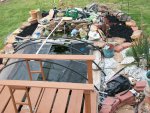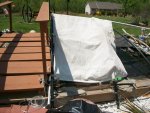I do not remember the precise number, but all of the hobbyist outlets seem to have some sort of number that, now after I have done this for a while, I honestly think they pulled the "shade percent number" out of their "uh oh".

Is this being asked due to algae concerns? If so, shading only helps to an extent, but, unless you're wanting to put a lid on your pond or entirely cover your pond with plant foliage, the shading will only help to a small extent. If there is even a sliver of water that gets exposed to sun light or filtered sun light, then I guarantee there will be noticeable algae growth if the nutrients are available.
I always viewed shading as a secondary benefit of plants. The primary benefit of plants is their nutrient consumption.
Readily available phosphates is generally the limiting variable for algae. Fish poo contains a tremendous amount of phosphates, but, as the poo decomposes, not all of the phosphates are readily available to be plant soluble (fertilizer), except eventually microbes make the phosphates into plant soluble.
Phosphate solubilizing microbes (PSM or PSB), that is whom makes phosphates plant available, are very finicky growers and takes proper conditions for them to release plant available (soluble) nutrients. All of the accumulating plant unavailable phosphates essentially creates a "phosphate bank", that converts to plant available phosphate rather slow or quite fast (depending on the PSM/PSB). So, even though your phosphate test kit says you have zero or very low phosphates, this is a lie since these easy, simple hobby phosphate test kits are only a test for soluble phosphates instead of testing the volume of the "phosphate bank".
As plants significantly grow their roots and start blooming, then the plant has a high demand for phosphates. Not all plants are created equal in their phosphate consumption, such as herbs and leafy green plants consume very little phosphate. You want a plant that is a prolific bloomer or prolific root grower (i.e., invasive plant), aided with proper pruning to get even more blooms or to control the roots, if you want your phosphates to lower.
If the shade question being asked is in context of algae concerns, then focus more on the type of plants you are growing.




